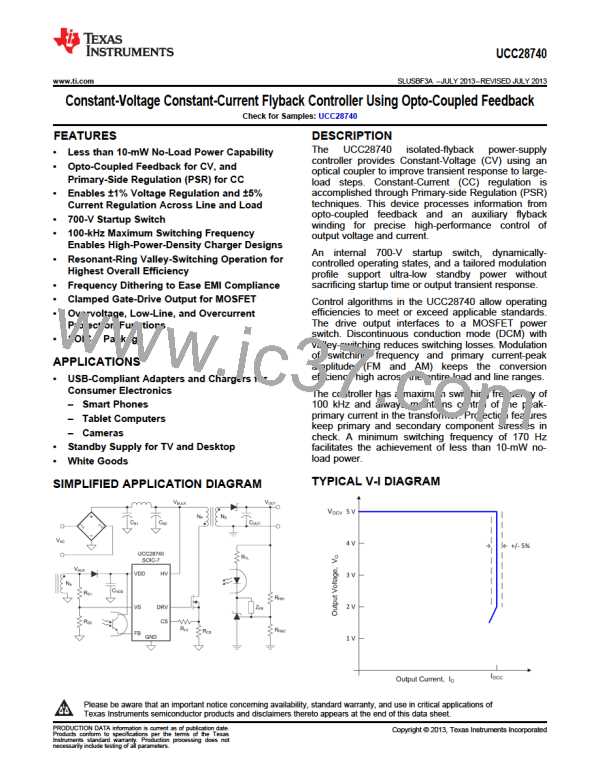UCC28740
www.ti.com
SLUSBF3A –JULY 2013–REVISED JULY 2013
(10)
Equation 11 provides an accurate solution for the total input capacitance based on a target minimum bulk-
capacitor voltage. Alternatively, to target a given input capacitance value, iterate the minimum capacitor voltage
to achieve the target capacitance value.
(11)
Transformer Turns-Ratio, Inductance, Primary Peak Current
The target maximum switching frequency at full-load, the minimum input-capacitor bulk voltage, and the
estimated DCM quasi-resonant time determine the maximum primary-to-secondary turns-ratio of the transformer.
Initially determine the maximum-available total duty-cycle of the on-time and secondary conduction time based
on the target switching frequency, fMAX, and DCM resonant time. For DCM resonant frequency, assume 500 kHz
if an estimate from previous designs is not available. At the transition-mode operation limit of DCM, the interval
required from the end of secondary current conduction to the first valley of the VDS voltage is ½ of the DCM
resonant period (tR), or 1 µs assuming 500 kHz resonant frequency. The maximum allowable MOSFET on-time
DMAX is determined using Equation 12.
(12)
When DMAX is known, the maximum primary-to-secondary turns-ratio is determined with Equation 13. DMAGCC is
defined as the secondary-diode conduction duty-cycle during CC operation and is fixed internally by the
UCC28740 at 0.425. The total voltage on the secondary winding must be determined, which is the sum of VOCV
,
VF, and VOCBC. For the 5-V USB-charger applications, a turns ratio range of 13 to 15 is typically used.
(13)
A higher turns-ratio generally improves efficiency, but may limit operation at low input voltage. Transformer
design iterations are generally necessary to evaluate system-level performance trade-offs. When the optimum
turns-ratio NPS is determined from a detailed transformer design, use this ratio for the following parameters.
The UCC28740 constant-current regulation is achieved by maintaining DMAGCC at the maximum primary peak
current setting. The product of DMAGCC and VCST(max) defines a CC-regulating voltage factor VCCR which is used
with NPS to determine the current-sense resistor value necessary to achieve the regulated CC target, IOCC (see
Equation 14).
Because a small portion of the energy stored in the transformer does not transfer to the output, a transformer-
efficiency term is included in the RCS equation. This efficiency number includes the core and winding losses, the
leakage-inductance ratio, and a bias-power to maximum-output-power ratio. An overall-transformer efficiency of
0.91 is a good estimate based on 3.5% leakage inductance, 5% core & winding loss, and 0.5% bias power, for
example. Adjust these estimates as appropriate based on each specific application.
V
´N
CCR
PS
R
=
´ h
XFMR
CS
2I
OCC
(14)
The primary transformer inductance is calculated using the standard energy storage equation for flyback
transformers. Primary current, maximum switching frequency, output voltage and current targets, and transformer
power losses are included in Equation 16.
First, determine the transformer primary peak current using Equation 15. Peak primary current is the maximum
current-sense threshold divided by the current-sense resistance.
Copyright © 2013, Texas Instruments Incorporated
Submit Documentation Feedback
23
Product Folder Links: UCC28740

 TI [ TEXAS INSTRUMENTS ]
TI [ TEXAS INSTRUMENTS ]